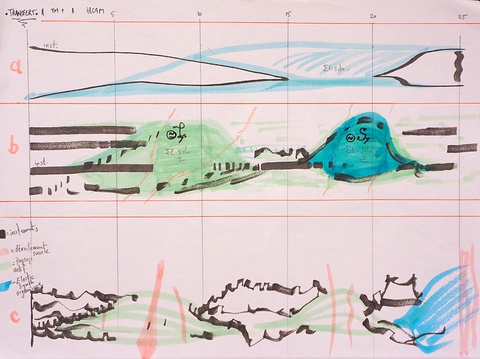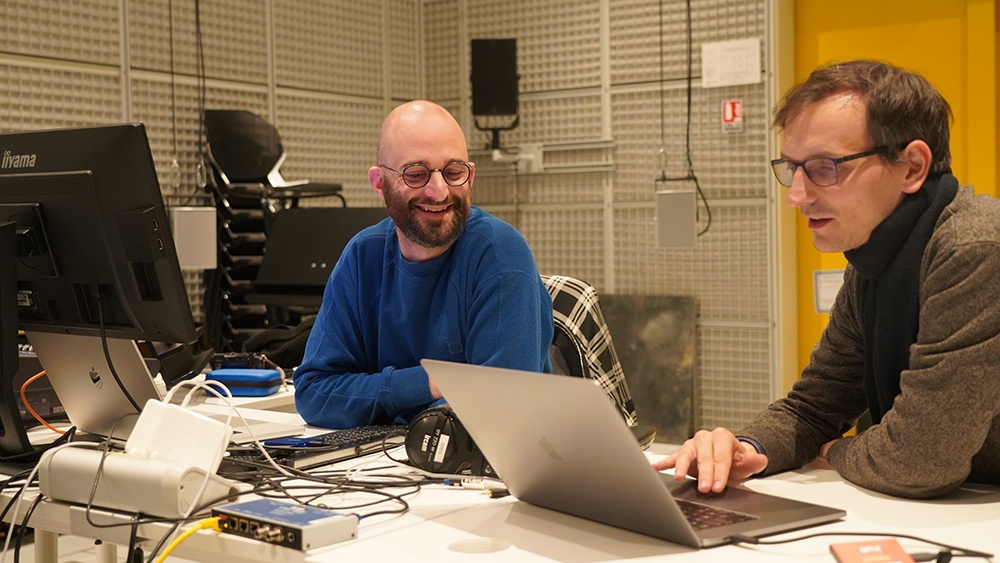« Transfert » pour 10 musiciens et électronique
Du transfert comme outil de composition - les enjeux artistiques
Nombreux sont ceux qui s’en vantent, rares sont ceux qui le sont réellement : Florent Caron Darras fait figure d’exception parmi la jeune génération de compositeurs. Non pas tant par sa formation : comme beaucoup de ses collègues, il est passé par les classes de composition (auprès de Stefano Gervasoni, Luis Naón et Gérard Pesson), improvisation, analyse, et esthétique du Conservatoire de Paris. Mais bien plutôt par ses centres d’intérêt annexes (ou connexes) à la composition : il consacre notamment une grande partie de ses recherches académiques au field recording (enregistrement sur le terrain) et aux paysages sonores – des sujets qu’il enseigne par ailleurs à l’université depuis près d’une décennie.


Esquisses, Transfert de Florent Caron Darras © Florent Caron Darras
C’est ainsi que le titre de l’œuvre qu’il compose à l’Ircam, Transfert, peut se lire de bien des manières. Ce « transfert », c’est d’abord et avant tout celui de toutes ses recherches dans le domaine du field recording vers son atelier de compositeur : c’est-à-dire de « composer » de toutes pièces (ou presque) un paysage sonore, mais surtout de plonger son auditoire dans une écoute autre, qui relèverait de celle que l’on aurait en pleine nature : écoute ambiancielle, contemplative et immersive, de matériaux répétitifs microvariés, en évolution douce, à peine perceptible. Une écoute qui, dixit Florent Caron Darras, se rapprocherait davantage de celle du monde de la techno – un aspect que l’on retrouve également dans la puissance des sons mis en œuvre.
En collaboration avec le réalisateur en informatique musicale Augustin Muller, le compositeur développe ainsi une pensée différente de l’espace. Différente par la multiplicité des points fixes dans le plan (comme en forêt), avec une grande finesse spatiale et une certaine complexité, mais aussi par rapport à l’écoute d’un lieu et de sa résonance : « L’ambisonique permet de travailler l’idée même d’acoustique, dit le compositeur. »

Florent Caron Darras et Augustin Muller, dans le studio 1 de l'Ircam © Ircam - Centre Pompidou, photo : Déborah Lopatin
Autre transfert : celui d’une certaine typologie de figures sonores, que l’on retrouve dans la nature (à commencer par les chants d’oiseau) vers l’écriture musicale.
« Chaque chant d’oiseau a sa temporalité propre, avec des microfigures rythmico-mélodiques qui reviennent, légèrement variées, entrecoupées de silence dont les rythmes sont eux aussi propres à chaque espèce. L’idée ici n’est pas de reproduire ou imiter un chant d’oiseau, comme ont pu le faire si magnifiquement d’autres compositeurs comme Messiaen, mais de créer de nouvelles figures musicales inspirées des typologies de chants d’oiseau que j’ai pu étudier. »
Pour le dire simplement, on pourrait comparer ce travail à celui d’un compositeur qui voudrait composer une chanson : il analyse le répertoire des chansons existantes, constate qu’il peut en dégager une forme globale avec couplets et refrain, et tâchera donc de produire une forme similaire, avec refrain et couplets. Si chaque chant d’oiseau est unique, ils ont des particularités communes (notamment temporelles), qui permettent aux individus de se faire entendre dans la nature, de se reconnaître, et de communiquer (ce qui nécessite du silence de temps à autre). Par exemple, certains oiseaux chanteront plutôt le matin, d’autres plutôt le soir. Leur chant pourra présenter d’abord des cris répétés en ralentissant et en decrescendo, suivis d’un silence d’une certaine durée (et l’on observe que ces durées sont sensiblement identiques d’une fois sur l’autre, et même d’un individu d’une même espèce à l’autre), puis de nouveau ces mêmes cris répétés, mais moins longtemps, etc.
C’est ce genre de figures que Florent Caron Darras essaie de produire pour peupler son paysage sonore, et faire de son ensemble instrumental une flopée d’animaux chimériques qui cohabiteront avec ceux peuplant déjà le dôme ambisonique…
Extrait de Transfert : Exemple de suivi de chant d'oiseau avec la synthèse FM spatiale
De la technologie comme outil de transfert - les enjeux technologiques
Car la trame du canevas musical de Transfert est fournie par un enregistrement réalisé par Florent Caron Darras en forêt, à l’aide d’un dispositif capable de capter un champ sonore avec une précision qui correspond peu ou prou à celles des perceptions humaines : il s’agit d’un micro comprenant 32 capsules, chacune orientée dans une direction de l’espace. Les 32 signaux récoltés permettent d’encoder ce champ sonore avec une complexité dite d’ordre 4.



Florent Caron Darras, en forêt, lors des enregistrements
Cette notion d’ordre peut être un peu difficile à appréhender, mais une petite analogie avec un sujet bien connu des musiciens permet d’en saisir le sens. Prenons un signal sonore (qui se déploie sur une certaine durée) : une analyse spectrale appelée transformée de Fourier permet de le décomposer en une somme de fréquences sinusoïdales de plus ou moins grande amplitude. Et plus on déterminera de ces fréquences simples composant le son, plus on arrivera à le décrire de manière fine. Avec la description d’un champ sonore, on utilise une décomposition en série de Fourier-Bessel – et l’ordre de l’encodage ambisonique donne une indication sur la quantité « d’harmoniques sphériques » (c’est-à-dire les composantes du son dans l’espace, et non plus simplement dans le temps) que l’on aura été capable de déterminer à partir des signaux captés par le micro. En l’occurrence, pour un encodage d’ordre 4, on aura 25 harmoniques sphériques.
 Ceci étant posé, l’idée du Transfert est de prendre l’empreinte spatio-temporelle du paysage forestier et de s’en servir comme d’un support, ou d’une source, pour plusieurs autres « transferts ». D’abord la reconstitution du paysage sonore enregistré sur le dôme ambisonique (et même sur tous les dômes ambisoniques car, entre celui de l’Espace de projection où sera créée la pièce, et celui du studio 1 où Caron Darras travaille avec Augustin Muller, le réalisateur en informatique musicale qui l’accompagne, de nombreux ajustements doivent être faits pour que les perceptions, notamment de proximité, soient fidèles à sa vision musicale), et sa restitution dans sa durée et sa temporalité – celles-ci étant donc « transférées » à la salle de concert.
Ceci étant posé, l’idée du Transfert est de prendre l’empreinte spatio-temporelle du paysage forestier et de s’en servir comme d’un support, ou d’une source, pour plusieurs autres « transferts ». D’abord la reconstitution du paysage sonore enregistré sur le dôme ambisonique (et même sur tous les dômes ambisoniques car, entre celui de l’Espace de projection où sera créée la pièce, et celui du studio 1 où Caron Darras travaille avec Augustin Muller, le réalisateur en informatique musicale qui l’accompagne, de nombreux ajustements doivent être faits pour que les perceptions, notamment de proximité, soient fidèles à sa vision musicale), et sa restitution dans sa durée et sa temporalité – celles-ci étant donc « transférées » à la salle de concert.
Autre transfert, celui des sons enregistrés vers des sons de synthèse. Les bruits de nature et chants d’oiseau captés par l’enregistrement ne seront plus réellement audibles dans la pièce finale : au lieu précis de leur émission dans l’espace, on pourra certes entendre des fragments mélodiques, mais ceux-ci seront produits par des synthétiseurs, dont les paramètres sont guidés par certaines caractéristiques des chants originels, choisies par le compositeur pour des raisons esthétiques.
« On n’entend pas le paysage réel, insiste Florent Caron Darras, mais des synthétiseurs pilotés par la vie sauvage, selon les mêmes emplacements d’espace et de temps. »
« Mon objectif, affirme le compositeur, est d’obtenir comme une forêt artificielle, qui reproduirait l’organicité de la forêt d’origine. »
![]()
Précédent projet à l'Ircam
2019 – Technotope pour saxophone baryton et électronique, 8 mn (Cursus)




